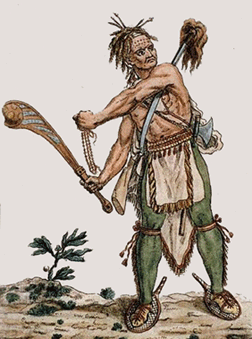
Location
The Iroquois indians homeland was located in what is today upsate New York between the Adirondack Mountains and Niagara Falls. At the height of the tribes exansion in 1680 they were in control of most of North America and East Canada(Sultzman, Iroquois History).
Women’s roles and Farming
The Iroquois Indians thought very highly of the women in their society. In the Iroquoian culture property were passed to the next generation through the female(Waldman,123). The women also elected the chiefs, which made up the governing body of the tribe and owned the crops (Sultzman).
One of the most important things that characterized Iroquoian society was their farming. The Indians used stone, bone, and wooden tools prepare their soil, for farming. Their most important crops were their corn, beans, and squash, and were also the three centerpieces of their religion. Festivals such as the Corn-Planting Festival, Green Corn Festival, and the Corn-gathering festival, emphasized the growing of corn(Waldman, 123).
The Longhouse
The Iroquois tribe lived in giant buildings made out of Elm bark called Longhouses. Longhouses were between 50 and 100 feet long and where home to up to 20 Iroquois families at a time. This made living conditions very crowed, noisy, and smelly. Iroquois Indians would build fires in the houses, which often left houses smoky because the only escape for smoke was through the holes in the roof (Waldman,122). Typically once longhouses were built they were not moved unless for defensive purposes, (Sultzman, Iroquois History).
Government Structure
Soon after the first Europeans arrived in the Americas, the Iroquois tribe formed the Iroquois Confederacy consisting of six nations, the Cayuga, Mohawk, Oneida, Onondaga, Seneca, and the Tuscarora. From these tribes a total of 50 chiefs or representatives were chosen to represent the nations(Waldman, 121-122). Although the nation acted appropriately for their domestic affairs, the council of chiefs met at Onondaga to decide on matters that were more significant to the entire Iroquois tribe, (History of the Iroquois). Some historians believe that the earliest founders of America such as Benjamin Franklin and George Washington modeled the American government after that of the Iroquois',(Waldman,122).


Relations with other Tribes
The Iroquois nations did not become allies until about 1570 due to the influence of Denganawida, the peacemaker, and Hiawatha, a Mohawk medicine man,(Waldman,121). In fact before they united these nations war inconstant war wit hone another. After the Iroquoian confederacy was established and the five tribes became allies, they became the military powerhouses of the Indians world. In 1570, the Iroquois engaged in a war with the Algonquin tribe in which they drove them from the Adirondack Mountains and the upper St. Lawrence River. The Iroquois also attacked the Mahican Confederacy, because of their engagement in the Wampum trade and attacked the Pocumtuc mostly likely because they were Mahican allies,(Sultzman,Iroquois History). The main reason that they attacked other tribes was for their furs, because their trading parteners, the Dutch and English, especially desired Beaver skins. In the 1600's they ravaged the Huron tribe to the north as well as The Tionontati, Neutral, and the Erie. They attacked the Susquehannock in the south. The Iroquois eventually dominated from the east Hudson River to the west Illinois river, and from the north Ottawa river the Tennessee river(Waldman,122-123).
Religion
Iroquois Indians believed in a god named Tarachiawagon, which means, "Holder of the Heavens." This God loved the Indians and encouraged them to love one another. He is a God who blesses the fruits and foods of the Earth. This aspect to their religion contributed to their sense of brotherhood. There was not distinct social classes and no on viewed themself as better than someone else
(The Bucknell Enviromental Center).



Relations with European Explorers
Jacques Cartier first traveled to St. Lawrence in 1535 at which time he encountered some Iroquoian-speaking people. He found them in eleven different villages between modern day Quebec and Montreal. Later when the French came back to check on them, the Iroquois were gone and different tribes inhabited the lands. Bot the Huron and the Mohawk, Iroquois nations claim descent from these Indians the French encountered(Sultzman, Iroquois history)

Works Cited
"History of the Iroquois." Sunbury: A History. The Bucknell Environmental Center, n.d. Web. 10 Sept. 2015. <http://www.departments.bucknell.edu/environmental_center/sunbury/website/HistoryofIroquoisIndians.shtml>.
Sultzman, Lee. "Iroquois History." Iroquois History. N.p., n.d. Web. 10 Sept. 2015. <http://www.tolatsga.org/iro.html>.
Waldman, Carl. "Iroquois." Encyclopedia of Native American Tribes. 3rd edition ed. New York: Checkmark Books, 2006. 121-25. Print.
Indians with Canoe-http://ryecityschools.milton.schoolfusion.us/modules/cms/pages.phtml?pageid=92408
warrior-http://www.iroquoisdemocracy.pdx.edu/html/iroquoisman.htm
long house- https://www.nysm.nysed.gov/IroquoisVillage/constructiontwo.html
Indians around Teepee- http://microcosm.binghamton.edu/category/cultures
Map- http://nativeamericannetroots.net/diary/1081
Indian Battle scene-https://revolutionaryfrontlines.wordpress.com/2010/07/15/native-american-lacrosse-team-refused-visas-to-enter-uk/
Iroquois farming- http://iroquoisgroup24.weebly.com/food.html
Backround- http://americanart.si.edu/exhibitions/online/catlinclassroom/catlin_browsepagetribe.cfm?StartRow=51